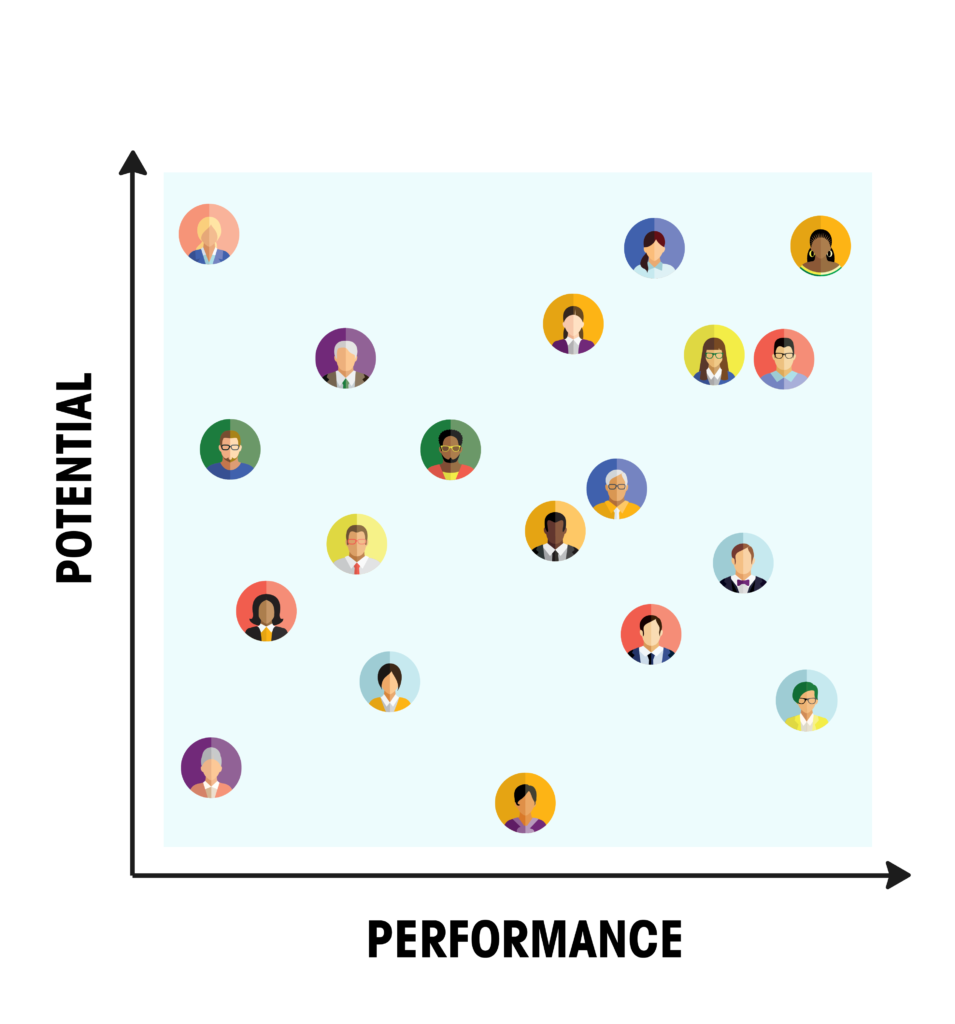Table of Contents
If you’re reading this article, your organization has got a great handle on employee success, and is making strides to introduce further fairness to your performance review process with employee talent reviews. These all-too-critical conversations help managers stay both objective and accountable for their reviews of their employees. And the 9-box is an excellent framework for guiding this important process.
Read on, or use the nav menu to jump ahead to the topic of your choosing. Either way, buckle in for great performance management -or as we like to say- “employee success” ahead.
What is a 9-box talent review?
A9-box talent review is a series of conversations between management, leadership, and HR about employees, their performance, and their potential. The employee themself is not involved in this conversation.
Wait. How is that different from a performance review?
Great question! An employee performance review (or Check-In) is a quarterly conversation that happens between the employee and manager about that person’s achievements, opportunities for growth future goals and professional aspirations. The emphasis is on individual development and success. The talent review (about the employee) comes first, and informs the Check-In performance review.
- Conversation about employee performance (between manager, HR and leadership) = talent review
- Conversation with employee about performance their success (between employee and manager) = Check-In performance review
With us so far?
Why do a 9-box employee talent review?
Employee talent reviews do not take the place of quarterly Check-Ins or performance reviews as they’ve been called up until recently. Instead, they strengthen manager and direct report performance conversations by introducing fairness, objectivity, and accountability into the review process. Instead of assigning a simple rating, talent reviews empower managers, with input from others, to evaluate employees both by their past performance and their perceived future potential. The emphasis is on company objectives.
Ultimately, talent reviews allow leaders to:
- Recognize and reward high performance and high potential
- Spot under-performing team members
- Build organizational bench strength for the future
Sound daunting? No worries — we’ve got just the tool for you. Try WorkTango’s favorite no-fail, easy-to-use talent review framework:
Meet the 9-box
Originally created by McKinsey for GE in the 1970s, the 9-box was first used to help senior leaders assess potential investments across their 150+ business units, according to two criteria: industry attractiveness and competitive strength.
Over the past 40 years, human resources teams co-opted this model as a talent management tool, and replaced the two industry axes with people-specific ones: performance and potential.

On the Y-axis, the 9-box asks managers to assess an employee based on their potential for growth as a future leader. Have they met challenges with positivity? Have they excelled in a variety of tasks? Do they lead by example? Can others look to them for input? Do they have good working relationships across the company? Do they have the skills and the motivation to advance and to remain with the organization?
On the X-axis, the 9-box asks evaluators to consider an employee based on their past performance. Are they someone who consistently exceeds expectations? Do they routinely underperform or barely meet requirements? Can their team count on them for high-impact projects?
The higher up and to the right, the better the performance and potential — and the more the employee is exceeding their manager’s and the organization’s expectations. The lower down and to the left, the more the employee needs skills development, or is a poor fit for the role they’re in.
The benefits of the 9-box talent review
So what’s all the fuss about?
The beauty of the 9-box system is that as leaders work to evaluate the people on their teams, it prompts them to move beyond an overly simplified, quantified rating by digging deeper and asking “Why?”
And in doing so, managers naturally gravitate toward tough conversations about how to better nurture their employees. This is something that can otherwise be easily neglected. And that process uncovers talent gaps, earmarks untapped top talent, and recognizes needs for leadership development. The best part? Because the system is simple and standardized, using a framework like the 9-box reduces the presence of inherent biases during the review process.
Need a strategy for workplace equality? Read:

A Roadmap for Ending Unconscious Bias in the Workplace
Arguments against the 9-box talent review
Despite those benefits, there are some who object to the 9-box, calling it impersonal, subjective, or just another rating system.
Honestly? These aren’t complaints about the 9-box itself. They’re what happens when the 9-box is used improperly.
But the 9-box isn’t a magic bullet, and it won’t automatically make your workplace fair. What does make your workplace more equitable is using the 9-box, or a similar tool, as a springboard for meaningful conversation, in which all parties are accountable for justifying their review of each employee.
Ready to use the 9-box with your team? Here’s how to start:
9 tips for using the 9-box talent review
- Be clear. What is the desired outcome of the process? What are the rules to play by that promote a fair, even process for everyone? Make sure each and every manager is on the same page, both before responding to the placement questionnaire and before having calibration conversations.
- Assemble a panel. Involve multiple voices in each evaluation. No employee should be evaluated by only one person.
- Be fair. Only leaders who have had repeated interactions with the employee should be involved in decision-making.
- Be prepared. Provide evaluators with a template to complete prior to the talent review meeting. This will allow them to come with clear thoughts and examples.
- Be specific. Encourage evaluators to avoid generalizations, and to provide specific examples of behaviors or instances that back up their choices.
- Use hard data. When possible, use technology to provide data regarding performance and employee engagement. Make all evaluations fact-based and data-driven.
- Encourage debate. In order to avoid blind spots and bias, leave plenty of room for differing opinions.
- Document everything. Document findings, and store for future reference.
- Leave with an action plan. The most important part of the talent review process is what comes next. Based on the findings of the conversation, create a list of specific steps – such as investments in new competencies, development plans, or even a termination – and follow through.
When properly executed, talent reviews lead to retention of the right people, strategic decisions about learning and developing, and strong succession planning for key roles.
And by relying on the 9-box, leaders don’t have to worry about reinventing the wheel; they can feel confident talent reviews are happening in a structured, consistent way.
It’s the 21st century, and the talent strategy is the business strategy. Are you ready?
Time for next steps:

The Ultimate Guide to Employee Performance Reviews
Employee success with WorkTango
We hope this article puts the tools in your hands to perform 9-box talent reviews with confidence and fairness in your organization. And if you feel like this approach can do a lot for your company, let’s talk.
Because at WorkTango, we’re passionate about bringing together all the tools you need to make work work better for everyone.



